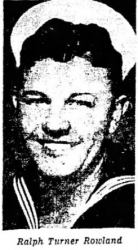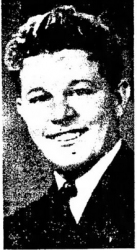
 |
|
|
||
|
Ralph Turner Rowland |
||||
|
Engagements: • World War II (1941 - 1945) |
||||
| Biography: | ||||
|
Ralph was the third child of Charles Turner and Myrtle "Myrtie" O. Gathright Rowland. They married about Feb 1910 and were the parents of three other children, Carl Eugene, Velma Lorene and Richard Curtis Rowland. Ralph graduated from John Brown Academy at Siloam Springs, AR in 1939. After graduation, Ralph worked on a dairy farm for awhile before deciding to enlist in the US Navy. He applied for enlistment at the Naval Recruiting Station in Oklahoma City in 1940. After his application was accepted, Ralph and his father drove the 200 plus miles to the Naval Recruiting Station, Dallas, TX where his father gave his permission for his son to enlist for six years. Ralph officially enlisted as an Apprentice Seaman (A.S.) on 19 Oct 1940 in Dallas, TX (NSN: 356-38-80). He reported to the Naval Training Station, San Diego, CA for recruit training several days later. Upon completion of his training, AS Rowland was detached and transferred to the newly commissioned destroyer USS Lang (DD-399) on 11 Dec 1940 in San Diego for duty. (During WWII, USS Lang received 11 battle stars for her service in the Atlantic and Pacific Theaters of Operation.) Rowland was advanced in rate to Seaman Second Class (S2c) on 19 Feb 1941. Less than six months after reporting on board the Lang, S2c Rowland was detached and transferred to the navy transport ship USS Henderson (AP-1) on 17 April 1941 as a passenger for further transport to the Asiatic Fleet. He reported on board the Henderson on 23 April 1941 in preparation for the long ride across the Pacific to the Philippines. By 15 May 1941, the Henderson had arrived in Manila. Rowland disembarked and reported to the USS Langley (AV-3) for assignment by Commander Patrol Wing Ten (COMPATWING Ten). He was assigned to Naval Ammunition Depot 4 & Submarine Base, Cavite, P.I. for duty on 26 May 1941. S2c Rowland was advanced in rate to Seaman First Class (S1/c) on 01 Aug 1941. The following month on 26 Sep 1941, S1c Rowland was detached from the Ammo Depot and transferred to the USS Edsall (DD-219) for duty. Ordered to comply with the Asiatic Fleet CINC Adm. Thomas C. Hart’s “defensive deployment” well south of Manila, units of the Asiatic Fleet, including destroyer tender USS Blackhawk (AD-9), USS Edsall (DD-219) and other ships of Destroyer Division (DesDiv) 57, got underway on 25 Nov 1941, and arrived on the morning of 29 Nov 1941 in Balikpapan, a major oil port on the eastern coast of Borneo. On 8 Dec 1941, Edsall, an element of Destroyer Division 57 (DESDIV), was enroute to Batavia (Djakarta) when word of the attacks on Pearl Harbor was received. The division altered course to Singapore to act as ASW screen for Force Z. From Singapore, Edsall was sent to search for survivors of HMS Prince of Wales and HMS Repulse, sunk off Malaya on 10 Dec. No survivors were found. It was learned later that other ships had retrieved the survivors. For the next month, Edsall and other units of DESDIV 57 were used to escort shipping to and from Australia. It was on one of these escort trips that Edsall participated in the sinking of IJN submarine (I-124) off Darwin. Several days later, Edsall was damaged during another attack on a suspected submarine. One of Edsall's depth charges exploded prematurely in shallow water damaging one of Edsall’s propeller shafts. This damage would play an important role in her eventual sinking about a week later. On 3 February, Edsall and other American units of the American-British-Dutch-Australian Force (ABDA) moved up to Tjilatjap, Java in order to be closer to the combat theater and refueling facilities. She continued her service as a patrol vessel off southern Java. On 26 February, she steamed from Tjilatjap with her sister ship USS Whipple (DD-217) to rendezvous with the converted seaplane tender USS Langley (AV-3) carrying P-40E fighters and crews for the defense of Java. On 27 February, the Langley, along with Edsall and Whipple, came under attack by sixteen (16) Mitsubishi G4M "Betty" bombers of the Japanese 21st and 23rd Naval Air Flotillas and escorted by fifteen (15) A6M Reisen fighters. The attack fatally damaged Langley. She had to be abandoned and later scuttled by Whipple. Edsall rescued 177 survivors; Whipple, 308. On 28 February, the two destroyers rendezvoused with the fuel replenishment ship USS Pecos (AO-6) off Flying Fish Cove, Christmas Island some 250 miles southwest of Tjilatjap. A sudden attack by land based Japanese bombers forced Edsall and the other ships to head for the open sea. They headed directly south into the Indian Ocean for the rest of 28 February in high winds and heavy seas. Early in the pre-dawn hours of 1 March, Whipple and Edsall transferred all the Langley survivors to Pecos. There were now close to 700 personnel on board the ship. Whipple then set off for Cocos Islands as protection for the tanker Belita sent to meet her there. The Pecos, carrying a large number of survivors was ordered to Australia. Edsall had retained 32 USAAF personnel from Langley needed to assemble and fly an additional 27 P-40E fighters shipped to Tjilatjap aboard the transport Sea Witch. Edsall was instructed to return these "fighter crews" to Tjilatjap. At 0830, she reversed course and headed back to the northeast for Java. At noon that day, planes from Japanese aircraft carrier Soryu attacked Pecos and struck again an hour later. Finally, in mid-afternoon, third and fourth strikes from aircraft carriers Hiryu and Akagi fatally wounded the Pecos. While under attack, Pecos radioed for help. After Pecos sank, Whipple returned to the scene intentionally arriving after dark. She eventually rescued 232 survivors. Many other survivors, although visible to crewmembers on board Whipple, had to be abandoned at sea because Whipple made sonar contact with what was believed to be several Japanese submarines. It was just too dangerous for her to remain in the area. Edsall may have heard Pecos’s call for help or she may have been complying with orders to reverse course and steam toward Australia. For whatever the reason, Edsall reversed course and was never heard from again. The US Navy Department simply said Edsall was lost due to enemy action. The US Navy Department declared all Edsall crewmembers “presumed dead” on 25 Nov 1945. This finding of presumptive death date was fixed in order to take care of settlements and claims. At that point no one suspected that survivors from Edsall were among many victims of war crimes on Celebes. Because no known survivors lived to tell the story, the details surrounding the sinking of Edsall remained largely a mystery for more than a half century. Finally, after historians compiled bits and pieces of information from various allied sources over the years, Japanese records and eyewitnesses on the Chikuma recently became available. The new information points to a short but epic battle involving the aging Edsall and one of the world's strongest naval forces of its day. After Edsall reversed her course on 01 Mar 1942 and steamed away from Java, she stumbled upon Admiral Nagumo's battle force, Kido Butai, that had been prowling the Indian Ocean in search of enemy shipping. Unfortunately, Edsall was spotted first. She was misidentified as a light cruiser of the Marblehead class. IJN battleships Hiei and Kirishima and heavy cruisers Tone and Chikuma were detached from the battle force to attack Edsall with surface gunfire. The old four-stacker began evasive maneuvers frustrating the Japanese for the next hour and half. However, because of the damage done previously to one of her propeller shafts, Edsall was unable to make top speed or maneuver fully. At one point Edsall turned and launched her torpedoes narrowly missing Chikuma. The Japanese fired some 1400 rounds resulting in only one or two direct hits. The frustrated Admiral Nagumo called upon his carriers to finish off the Edsall. She was attacked by dive-bombers from two Japanese carriers (Kaga, Soryu,) and possibly a third (Hiryu) before succumbing to this devastating attack. The Edsall went down at 1900 hours, 01 Mar 1942, 430 miles south of Java. Japanese eyewitnesses confirm that at least eight Edsall crewman from a large number of survivors were fished out of the water and brought on board the Chikuma. The rest of the survivors were left to their fate in the water. Chikuma and the rest of the battle force arrived at Staring Bay anchorage, Celebes on 11 Mar 1942. Three dozen POWs, 8 or more from the Edsall and the remainder from a Dutch ship, were turned over to the Japanese Special Naval Landing Forces based at Kendari where they were executed on 24 Mar 1942 near Kendari II airfield. The Edsall's final muster report was completed after the war's end. S1c Ralph Turner Rowland was listed as missing in action on 01 Mar 1942. His remains were unrecoverable. He was posthumously awarded the Purple Heart, American Defense Service Medal with Fleet Clasp, Asiatic-Pacific Campaign Medal with two battle stars, Philippine Defense Ribbon, and World War II Victory Medal. He may also be eligible for the Combat Action Ribbon (Est. 1969 and retroactive 07 Dec 1941). [bio #3 composed by Gerry Lawton (GML470) Find A Grave memorial page: 56790778 |
||||
| Honoree ID: 160177 | Created by: MHOH | |||
Ribbons
Medals
Badges
Honoree Photos
 |  |  |
 |  |
 |


